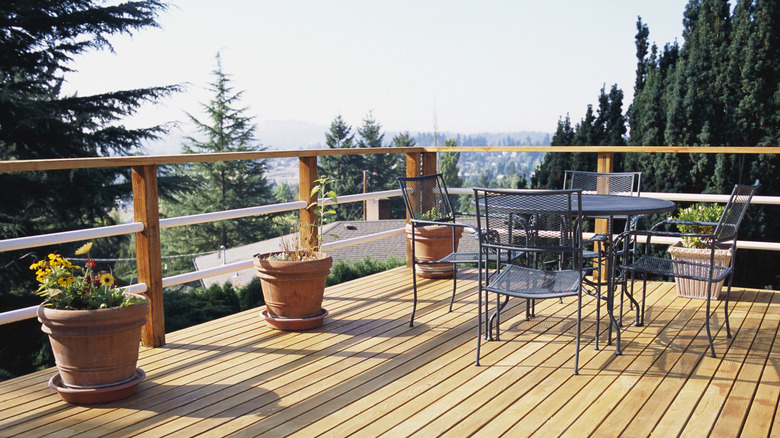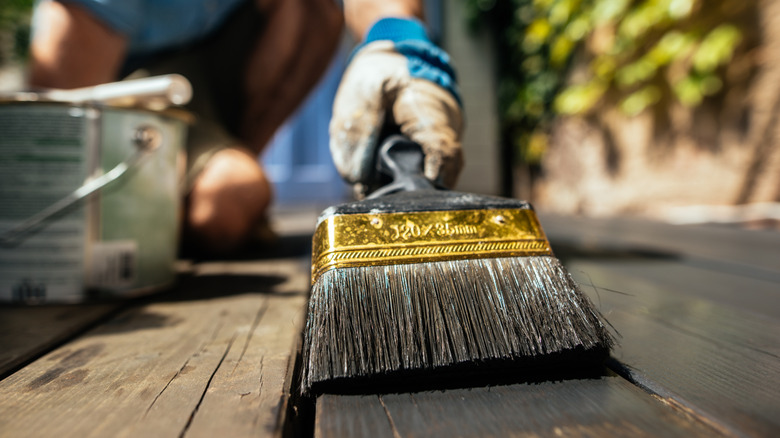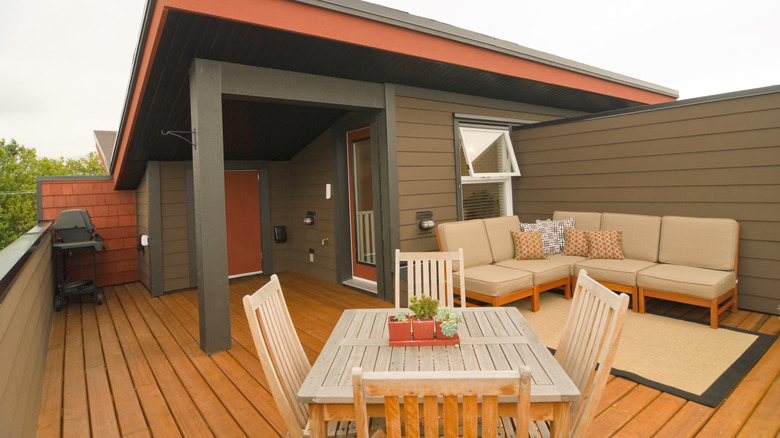The Most Common Deck Staining Mistakes We're Tired Of Seeing
Skipping surface preparation is one of the most common and avoidable mistakes in deck staining. As Shay LaRue, Virtual Handyperson Expert at Frontdoor, an all-in-one app and service that connects homeowners with skilled tradespeople to discuss their home care and maintenance issues on an enhanced video chat, told Outdoor Guide exclusively, "Prepare your deck surface first for best staining results." Preparation is critical because it ensures the stain adheres evenly and lasts longer. If you can't bend down to apply the stain, there's an easier way to paint or stain your deck, and all you need is a broom, which can act as a giant paint brush.
LaRue also emphasizes using multiple cleaning tools to achieve the best results. "I like to use both a push broom and a leaf blower," he says, highlighting that thorough debris removal is key before moving on to pressure washing. Once clean, the deck should be washed with a deck cleaner to remove ingrained grime. "Sanding will get you into the next layer of grain for better stain penetration," he adds, noting that while sanding isn't always required, it can make a noticeable difference in the stain's appearance.
Skipping these steps can lead to uneven staining, which LaRue warns is difficult to fix later. "You should never stain a deck in direct sunlight or during an extremely hot and humid day," he cautions, reminding homeowners to also consider the weather, as well.
Not maintaining your deck is where most people go wrong
Homeowners often overlook ongoing deck maintenance, leading to costly mistakes. Many people fail to restain their decks frequently enough, even though wood finishes wear down subtly over time. Unlike paint, which visibly chips, stain fades gradually or loses its water resistance, making the deterioration harder to notice. As a general guideline, wood decks should be restained every two to three years to protect against fading, mold, and mildew. Neglecting this routine can lead to damage that is both unsightly and expensive to fix, such as fading and the development of mold and mildew, which can ruin the look and integrity of your deck.
LaRue also stresses the importance of drying time. "Allowing the stain to dry completely is very important," he says. "To achieve this, you may have to protect it from the weather, elevated tarps or covering will work. After your deck is completely dry, consider using a sealer on the stain," he adds, naming transparent options like Thompsons or Behr Premium as effective choices.
Ignoring the details can shorten your deck's life
One of the easiest mistakes to make is forgetting the little details. "Everyone seems to forget that boards have ends and corners!" says LaRue. Neglecting to stain these areas not only affects the deck's appearance but also leaves the wood vulnerable to moisture damage. "To seal your deck properly, remember to stain these areas as well," mentions LaRue. Stain acts as a barrier, and skipping these spots can lead to rotting or splitting over time.
To simplify the process, having the right tools on hand and sticking to a regular maintenance schedule is essential. A well-maintained wooden deck not only adds value to your home but also provides an inviting space for outdoor living. Beyond aesthetics, proper care ensures the deck remains structurally sound, avoiding issues like warping or rotting. From thorough preparation before staining to sealing and monitoring for wear, addressing these key details can save you from expensive repairs and keep your deck looking its best year-round.


